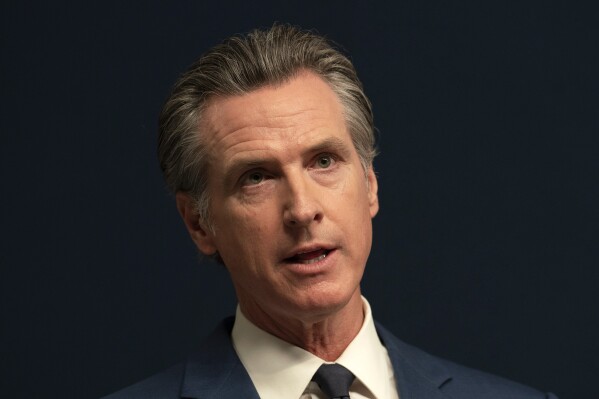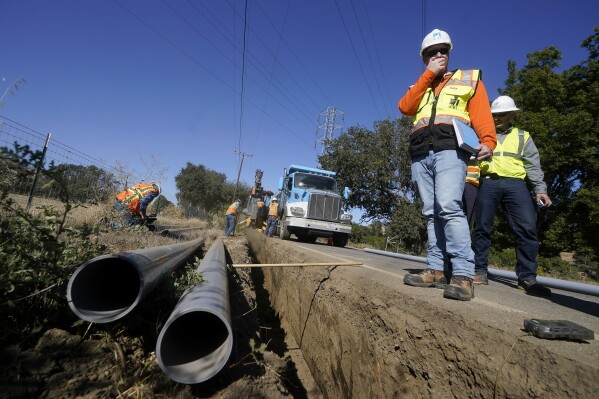Biden announces $3.5B for projects nationwide to strengthen electric grid, bolster resilience
WASHINGTON (AP) — The Biden administration on Wednesday announced $3.5 billion for 58 projects across the country to strengthen electric grid resilience as extreme weather events such as the deadly Maui and California wildfires continue to strain the nation’s aging transmission systems.
Energy Secretary Jennifer Granholm said it was the largest federal investment ever in grid infrastructure, supporting projects that will harden electric systems and improve energy reliability and affordability. The federal spending, combined with money promised by private partners, could result in up to $8 billion in investments nationally to upgrade the grid, Granholm said.
“The grid, as it currently sits, is not is not equipped to handle all the new demand” and withstand natural disasters and extreme weather worsened by climate change, Granholm said at a news conference Wednesday. “We need it to be bigger, we need it to be stronger, we need it to be smarter” to bring a range of renewable energy projects online and meet the Biden administration’s goal of reaching 100% clean electricity by 2035, she said.
Projects funded by the federal Grid Resilience and Innovation Partnerships program will increase the flexibility, efficiency and reliability of electric power systems, with a particular focus on spurring solar, wind, and other renewable energy, Granholm said. The projects also are aimed at fixing problems that may contribute to wildfires and other disasters and will improve reliability by deploying innovative approaches to electricity transmission, storage and distribution, she and other officials said.
 In big year for labor, California Gov. Gavin Newsom delivers both wins and surprises
In big year for labor, California Gov. Gavin Newsom delivers both wins and surprises
 PG&E’s plan to bury power lines and prevent wildfires faces opposition because of high rates
PG&E’s plan to bury power lines and prevent wildfires faces opposition because of high rates
 California Gov. Newsom signs law to slowly raise health care workers’ minimum wage to $25 per hour
California Gov. Newsom signs law to slowly raise health care workers’ minimum wage to $25 per hour
Projects to be funded include $249 million each for rural areas in Georgia and Louisiana and $250 million for a Native American tribe in Oregon.
The largest grant, $464 million, will go to improve five transmission projects across seven Midwestern states, from Iowa to North Dakota. The money includes $95 million previously announced for Hawaii in the wake of devastating wildfires this summer, and $150 million to PacifiCorp to upgrade the grid and boost wildfire mitigation in California, Oregon, Utah and other states.
“Our outdated grid has been in need of an update for a long, long time,″ said Mitch Landrieu, a White House senior adviser who coordinates implementation of the 2021 infrastructure law signed by President Joe Biden.
The grid “is especially vulnerable to the increasing impacts of the climate crisis,” Landrieu added. “Older equipment can overload during extreme heat and cold when power is needed most. And it’s more likely to fail when communities are washed out by historic floods and decimated by stronger storms.’'
The nation’s existing power grids are not built to handle the growing energy demand, a fact that is complicated by the intermittent nature of renewables, since energy isn’t generated when the sun doesn’t shine or the wind isn’t blowing.
“As we sadly saw in California, aging electricity infrastructure can cause catastrophic loss of life, property, natural areas and forest fires,” said Jonathan Foley, executive director of Project Drawdown, a San Francisco-based group that publicizes climate solutions.
The projects announced Wednesday are “exactly the kind of thing that we should be doing: promoting renewables, better storage and better electrical grids for a better, greener, more resilient future,” Foley said.
In Georgia, the state’s environmental finance authority and companies that supports Georgia’s electric cooperatives will team up on a project to upgrade the grid, including investments in battery storage, local microgrids, grid reliability and new transmission lines. The project will focus on remote, historically underinvested communities, Granholm said, including rural Locust Grove, Georgia, where she visited Wednesday as part of the grant rollout.
In Louisiana, two projects will focus on helping disadvantaged communities withstand extreme weather and develop microgrids to work with local utilities and back up existing assets. Entergy New Orleans also will enhance the local grid’s resilience to severe weather, including hardening existing transmission lines and distribution systems to reduce outage frequency and duration.
CPS Energy in San Antonio will receive $30 million for a resiliency program, and Minnesota-based Xcel Energy will receive $100 million for projects in Texas, Colorado, New Mexico, Minnesota and Wisconsin to mitigate wildfire risk, including thousands of fire-resistant poles. Texas has faced repeated challenges, from sweltering heat this summer to a winter blackout in 2021 that knocked out power to millions of customers and resulted in hundreds of deaths.
In Michigan, Consumers Energy will get $100 million to strengthen electric systems in disadvantaged communities where outages are more frequent, including northern Michigan and the Flint and Grand Rapids areas. DTE Energy, meanwhile, will receive $23 million for adaptive microgrids in the Detroit area to enhance reliability and reduce outages.
In Oregon, the Confederated Tribes of Warm Springs Reservation will work with Portland General Electric to upgrade transmission capacity and improve service east of the Cascade Mountains, including the reservation.
___
Associated Press writer Isabella O’Malley in New York contributed to this story.
Disclaimer: The copyright of this article belongs to the original author. Reposting this article is solely for the purpose of information dissemination and does not constitute any investment advice. If there is any infringement, please contact us immediately. We will make corrections or deletions as necessary. Thank you.







